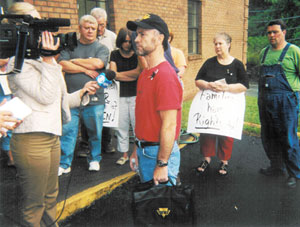|
Defend Labor Rights
Join Militant Fighting Fund campaign to defeat Utah coal mine boss lawsuit.
|
|
lead article
Miners’ families demand ‘Justice!’
Hold picket lines in Harlan, Kentucky, to
protest exclusion from probe of deadly blast

|
Militant/Eddie Beck
|
UMWA safety official Kenny Johnson (center) at MSHA office in Harlan, Kentucky, June 2, where relatives of miners killed in a May 20 explosion at Darby Mine No. 1 protested their exclusion from government investigation. At right is Teddy Stewart, brother-in-law of Roy Middleton, who was killed in the blast. Next to him is Nellie Middleton, Roy’s mother.
|
BY SAM MANUEL
HARLAN, Kentucky, June 2—Family members of miners killed on the job here protested today the exclusion of their representatives from investigations by state and federal officials into the May 20 explosion at the Darby Mine No. 1 where five miners died.
Attorney Tony Oppegard and United Mine Workers of America (UMWA) safety official Kenny Johnson, who represent the families, were excluded from the state investigations. They participated in the federal investigation, which was held separately, after several miners who had been called as witnesses designated them as their representatives.
According to the county coroner, miners Amon Brock, 51, and Jimmy Lee, 33, were killed by the explosion. Roy Middleton, 35; George Petra, 49; and Paris Thomas Jr., 53, survived the blast but suffocated from carbon monoxide.
The June 2 picket was the second protest organized by the families. Two days earlier they protested the exclusion of Oppegard and Johnson from investigations held by state mine safety and health officials. Two state troopers were stationed in the hallway apparently to prevent family members and the media from going near the hearing room. They were removed the second day. State mining officials closed the hearing, saying they wanted to encourage witnesses to be forthcoming without fear of intimidation.
Several family members pointed out that the mine boss and the company’s attorney were allowed to sit in on the entire investigation. “What kind of justice is that?” asked Teddy Stewart, brother-in-law of Roy Middleton.
“What do they have to hide?” asked Tilda Thomas, holding a sign that read, “Families Have Rights Too!” The widow of Paris Thomas Jr., she stood in the lobby of the Harlan Mine Safety and Health Administration (MSHA) building with a dozen family members of other miners killed.
Thomas told the Militant her family has gotten no offer of assistance from the company and that with the exception of a call to express his condolences she has heard nothing from the mine’s co-owner, Ralph Napier. “We weren’t even told the hearings were taking place until we found out in the newspapers,” she added.
She received a letter stating that the family’s insurance is paid for six more months, she said. After that it will cost her $207 a month to continue the coverage. “Where am I or any of these families going to get an extra $207 a month?” she asked.
“Company reps in, Family reps out! Why?” read the sign held by Priscilla Petra. Her husband, George Petra, survived the explosion but was overcome by carbon monoxide gases.
“Who has more of a right to be in there than the families?” Paul Ledford told the Militant.
Ledford is the only survivor of those working in the mine during the May 20 explosion. Ledford said he thought his respirator stopped working after about 10 minutes. As he tried to get out of the mine he passed out twice. After regaining consciousness the second time he was able to signal rescuers using his helmet light. Ledford said investigators
told him that his respirator worked and that he most likely overran the rate at which the device produces oxygen.
The U.S. Senate recently passed legislation requiring mine operators to provide miners with breathing devices that contain two hours of oxygen instead of the current one hour. The House approved a similar bill June 7, which, in addition to the two hours of air, also requires mine owners to provide communication and tracking devices to miners within three years.
Teddy Stewart said the legislation was too late. “They ought to have enough air for the miners to survive like they had in Canada,” said Stewart. He was referring to the successful rescue of 72 potash miners in Canada in January who survived for hours in safety rooms underground that were equipped with 36 hours of air, food, and water.
The Kentucky miners and their families won a small victory when Oppegard and Johnson announced that several miners who had been called as witnesses had designated them as their representatives. “We preferred to go in as representatives of the families,” Johnson said. “We are sure that the miners will want us to keep the families informed. That is what several have told us. They want to help the families.”
Investigators say the explosion was likely caused by a methane gas leak from a sealed-off section of the mine. According to the Associated Press, miner Tony Bledsoe said he told state investigators that he had been instructed to build the seals at the Darby Mine No. 1 without receiving any training.
Bledsoe said the blocks used to construct the seals were easily broken and that half of them cracked on the delivery truck. The driver of the truck declined to be interviewed upon leaving the federal investigation.
Until the 1990s, seals were constructed with concrete blocks. MSHA has recently allowed mine owners to use a foam-type material called an Omega Block, which is cheaper and can easily be lifted by one worker, requiring smaller crews. Rescuers at the Darby mine reported these blocks did not withstand the blast.
Eddie Beck from Newark, New Jersey, contributed to this article.
| 


